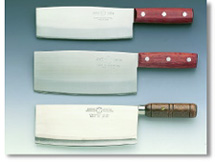
A cook’s single most important tool is a good knife; after all, you use your knife at least once for each dish that you cook — at least, I certainly do. A good knife, well maintained, makes fast work of any cutting task, and is easier to use (and use well) than a cheap or poorly-maintained knife. [1]
Start by purchasing a high-quality knife. My favorite knives are made by Zwilling J.A. Henkels AG (of Germany); I prefer their “Four Star” series, but their “Professional S” series is also very good. [2]
Next, keep your knife sharp! You’re not only more likely to cut yourself with a dull knife than with a sharp one, but cuts from dull knives hurt more and leave worse scars. If you’re into it, learn how to use a stone and a steel and then do so often. For the rest of us, a half dozen passes with an AccuSharp every six months or so and a few passes through a “Chantry” by Messermeister. (I’d give you a more specific URL but the folks at Messermeister have seen fit switch to a 100% Flash-based web site. Idiots.)
Part of keeping your knife sharp is to always use a cutting board. The best ones are made of wood or thick polyethylene; there’s even a model from Bemis of wood and phenolic resin that has all the great qualities of a wooden board and is dishwasher-safe to boot! Buy several large boards and use them religiously. [3]
Store your knife in a block; if your block has vertical slots, insert the blade with the edge facing up. Do not leave your knife laying on the counter or on the sink. A knife belongs in one of three places: In the block, in your hand, or on the cutting board.
Don’t use your knife for anything except cutting. If you have to use it to scrape things off your cutting board, use the top of the blade and not the edge. Better yet, buy a pastry scraper.
As soon as you’re done using it (and as necessary between food items), wash your knife by hand, using a mild detergent and luke-warm water, then dry it immediately. Never put your knife in the dishwasher! Why luke-warm water? Well, in theory, rapidly changing the temperature of a knife blade can affect the temper of the steel and its ability to hold an edge; taken to extremes, the blade can become brittle and crack under normal use. Some people wash their dishes in very hot water (upwards of 140F) and then rinse them in very cold water (as low as 40F); this may not be enough to affect the steel, but why take a chance? Besides, there’s no need to use hot water to get your knife (or your dishes, for that matter) clean enough for household use. (You don’t need to wash your hands in hot water to get them clean, either, but that’s another rant altogether.) [4]
[1] You may have noticed I say “knife” and not “knives”; this is intentional. I feel pretty strongly that you should find a knife you like and stick with it for almost all cutting and chopping.
I recommend you buy a “chef’s” knife (also known as a “cook’s knife” or a “French chef’s knife”) as your primary knife. For most men I suggest one with a 10 inch blade; for most women I suggest an 8 inch blade; bigger than 10 inches is more than you need for anything except watermelons. At first those blades may feel too big for you; in time I think you’ll find they’re just right, and using too small a blade makes the job that much harder.
The second knife you should buy, even though it probably won’t be used much, is a small paring knife. They come in various sizes and shapes with names like “bird’s beak,” “sheep’s foot”; get one with a 3 inch blade that looks like this:

There are, of course, specialty knives: Carving knives, boning knives, bread knives, decorating knives, sandwich knives, tomato knives, salmon slicers, ham slicers … The list is a long one, but very few of the knives on it are worth owning. The one exception is a “Chinese cleaver” or “choy doh”; these look like butcher’s cleavers but are really knives. I prefer these to my chef’s knife when boning chickens and for chopping very large quantities of vegetables (because the added weight makes the job easier). Joyce Chen makes two very nice ones: model 50-0750 (middle) and 50-0052 (bottom); I own the 50-0750, but the 50-0052 is nice, too.

[2] Don’t be fooled by handle shapes like those of Henkels’ “Five Star” series: They look like they’re comfortable, and if you grab the knife full in your hand (as Father Capon says, “like you’re about to commit mayhem”) they are comfortable — but that’s not how you hold a knife for cooking. When you take the proper grip, you find out those “ergonomic” handles actually suck.
[3] You can now find very thin, flexible polyethylene cutting boards, but I don’t recommend them, mostly because they just don’t offer enough cushioning against knife “strike.” They also don’t last as long as the thick boards.
[4] To avoid cutting myself, I like to use a small vegetable brush to wash my knife, rather than a sponge or a dish rag.
| [Up to the recipe index] | [Abbreviations] | [Back to AdamM’s home page ] |